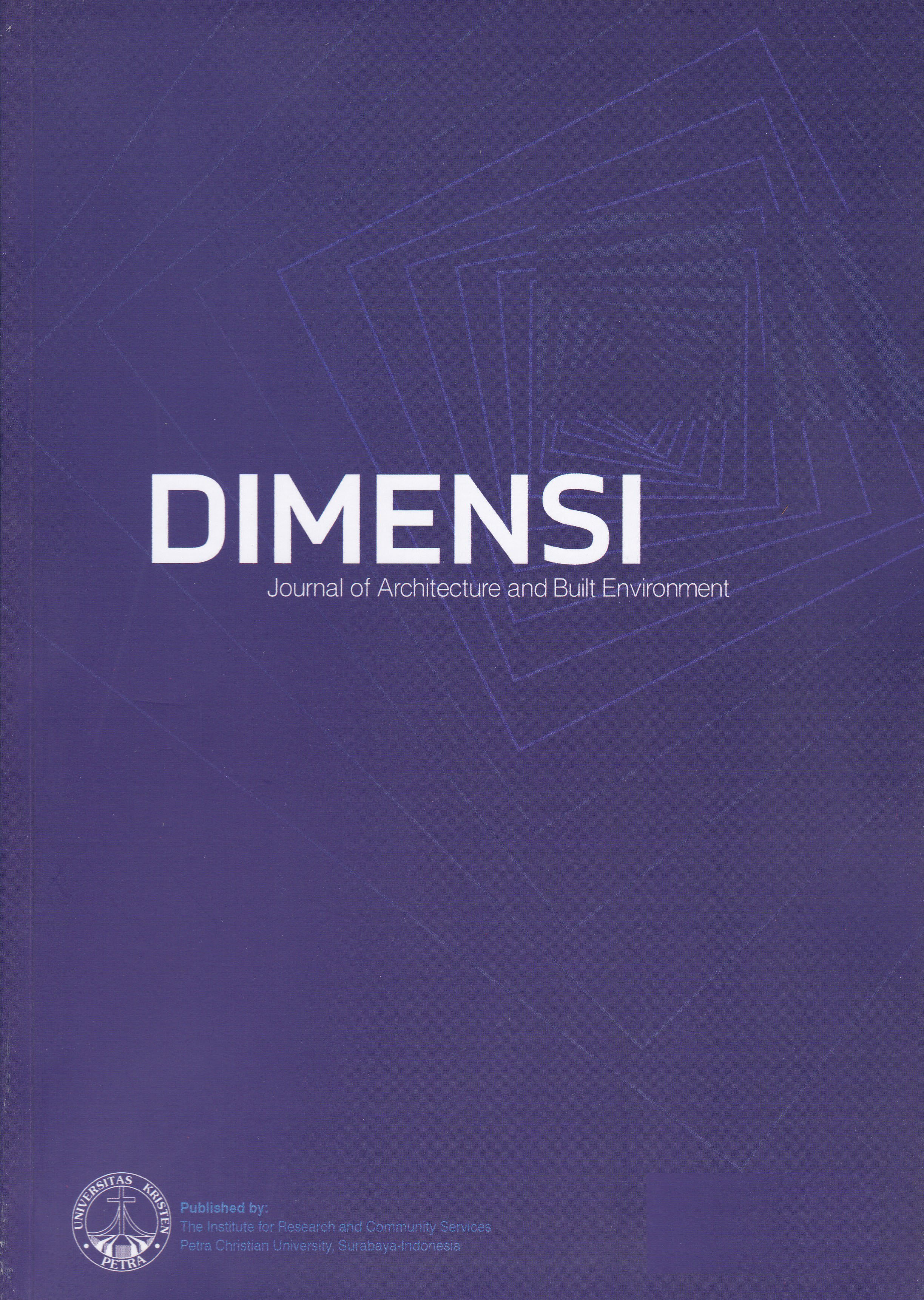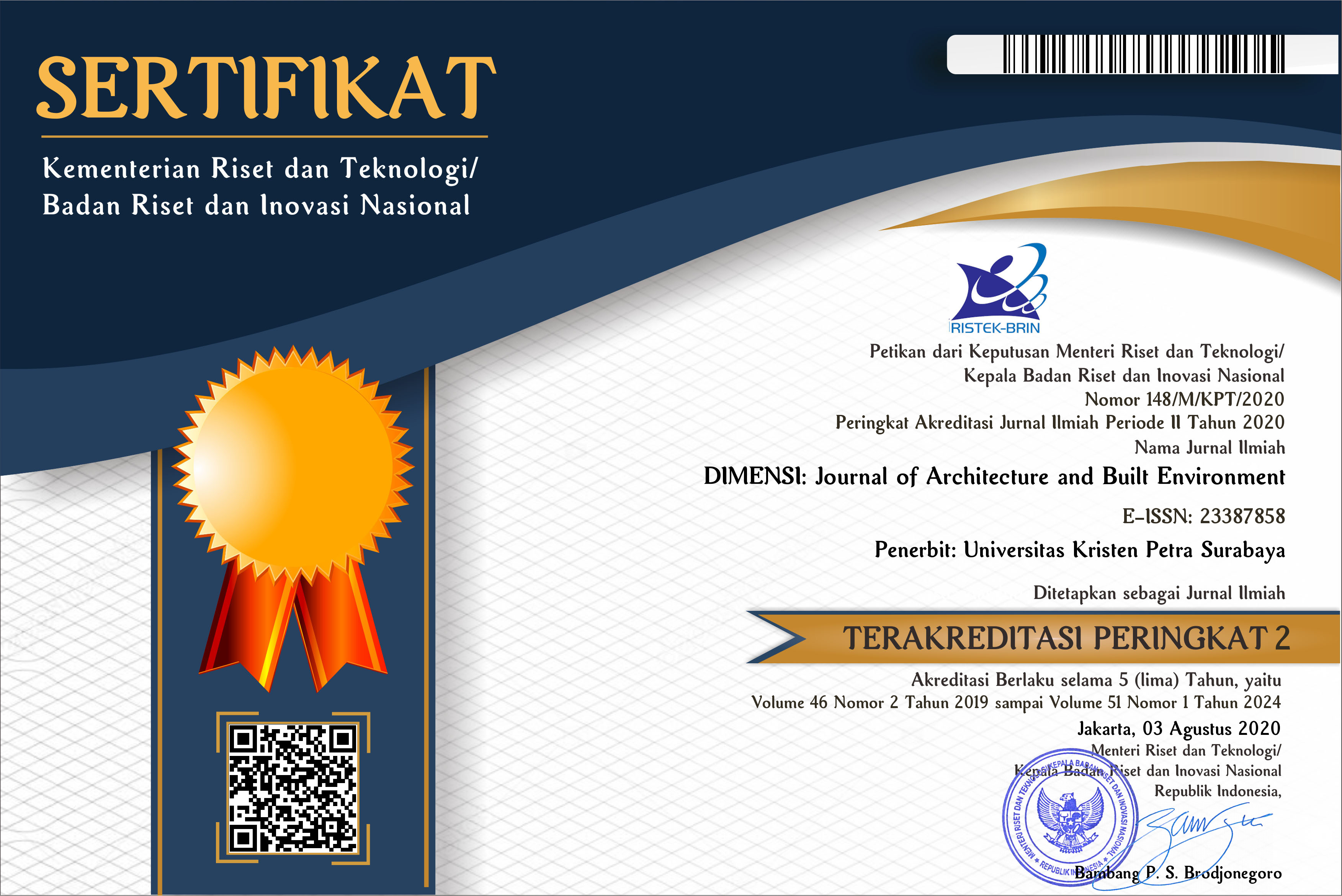INDOOR AIR QUALITY STUDY ON COASTAL BAILEO IN WEST SERAM, MALUKU
 :
:
https://doi.org/10.9744/dimensi.47.1.35-42
Keywords:
Indoor Air Quality, coastal Baileo, West SeramAbstract
Thermal comfort is one of the most influencing aspects to affect comfort level in interior. Indoor Air Quality (IAQ) is one part of thermal comfort parametric often suggested in any building assessment for its role to affect health and comfort. IAQ is influenced by physical factors (temperature, air humidity and air velocity) and chemical factors (in the form of substances in the air). Traditional buildings in Indonesia, has long since consider IAQ in its passive design approach, one of them is in Baileo. This paper reports an investigation of IAQ in coastal Baileo in West Seram, Maluku. This quantitative research is conducted in method comparative analysis method. This paper discusses the relation between IAQ in Baileo to building formation and materials selection. The measurement done show that IAQ in coastal Baileo in West Seram has good performance on both physical and chemical factors.
Downloads
References
Alfiah, Tatty. (2009) Pencemaran Udara. Lingkungan Institut Teknologi Adhi Tama, Surabaya.
Givoni B. (1998). Climate Considerations in Building and Urban Design. Van Nostrand Reinhold, New York.
Green Building Council Indonesia. “Greenship Interior Space Version 1.0”. April 2012. Accessed: 15 Oktober 2018 < http://www.gbcindonesia.org/greenship/rating-tools >
Handoko, Wuri. (2007). Asal-Usul Masyarakat Maluku, Budaya dan Persebarannya: Kajian Arkeologi dan Mitologi. Kapata Arkeologi, 3, p.5-10.
Jiang, Chuanjia, Dandan Li, Pengyi Zhang, Jinge Li, JuanWang, JiaguoYu. (2017). Formaldehyde and volatile organic compound (VOC) emissions from particleboard: Identification of odorous compounds and effects of heat treatment. Building and Environment, 117, p.118-126
Karyono, Tri H. (2013). Arsitektur dan Kota Tropis Dunia Ketiga :Suatu bahasan tentang Indonesia. Rajawali Pers, Bandung.
Lafond, Adrien. IAQ Standards and Guidelines (EPA and ASHRAE Standard). ND. Accessed: 20 Januari 2020 <https://foobot.io/guides/iaq-standards-and-guidelines.php >
Lafond, Adrien. The US Environmental Protection Agency's (EPA) List of Volatile Organic Compounds. ND. Accessed: 20 Januari 2020 <https://foobot.io/guides/us-epa-list-of-volatile-organic-compounds.php >
GreenFacts Scientific Board. (2019). Which chemicals found in indoor air are causing the most concern?. Access 26 November 2013. <https://copublications.greenfacts.org/en/indoor-air-pollution/l-2/6-harmful-chemicals.htm >
Salthammer, T. , S. Mentese, R. Marutzky. (2010). Formaldehyde in the indoor environment. Chem. Rev., 110, pp. 2536-2572
U.S. Environmental Protection Agency. “Indoor Air Quality : What Are Trend in Indoor Air Quality their effects on human health”.EPA. n.d. Accessed: 15 Oktober 2018 < https://www.epa.gov/report-environment/indoor-air-quality >
U.S. Environmental Protection Agency. (2003). EPA assessment of risks from radon in homes. Environmental Protection Agency of US, Washington.
Wattimena.Lucas. (2013). Arsitektur Rumah tradisional di maluku (studi etnoarkeologi). Berkala Arkeologi, 33, p.201-210.
World Health Organization. (2010). WHO guidelines for indoor air quality: selected pollutants.
Downloads
Published
How to Cite
Issue
Section
License
Authors who publish with this journal agree to the following terms:
- Authors retain copyright and grant the journal right of first publication with the work simultaneously licensed under a Creative Commons Attribution License that allows others to share the work with an acknowledgement of the work's authorship and initial publication in this journal.
- Authors are able to enter into separate, additional contractual arrangements for the non-exclusive distribution of the journal's published version of the work (e.g., post it to an institutional repository or publish it in a book), with an acknowledgement of its initial publication in this journal.
- Authors are permitted and encouraged to post their work online (e.g., in institutional repositories or on their website) prior to and during the submission process, as it can lead to productive exchanges, as well as earlier and greater citation of published work (See The Effect of Open Access).



















